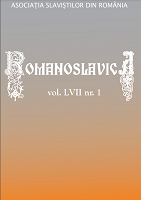MARCAREA DIFERENȚIALĂ A COMPLEMENTULUI DIRECT ÎN LIMBA SLOVACĂ
The Differential Object Marking in Slovak
Author(s): Marilena Felicia Luță (Țiprigan)Subject(s): Lexis, Semantics, Western Slavic Languages
Published by: Asociația Slaviștilor din România
Keywords: Direct Object Marking; Telicity; Scalarity; Verbal Aspect;
Summary/Abstract: Based on the examples extracted from the very written texts of our students, we identified the typological characteristics conditioning the DOM phenomenon in Slovak. They concern both the nominal and the verbal inflexion aiming at distinct paradigmatic models for each gender and for each class of verbs. An important part is played by the animate vs. inanimate subcategory, relevant to the declension of the masculine nouns, which is mirrored in the whole nominal inflexion system and has an impact on case syncretism and asymmetric dualism, as well. Despite the fact that Slovak has no article, deictics may take on the role of the articles. The lexico-semantic characteristics of verbs, especially telicity, are inextricably linked to their lexico-grammatical categories such as: valence, intention, verbal aspect, and implicitely to DOM. Scalarity as closely related to telicity characterizes perfective verbs entailing a direct object as a obligatory syntactic position. The thematic roles of the obligatory arguments (Patient and Agent) may also lead to predictability when it comes to DOM. Word order is mostly relevant with pronouns as it implies the use of the stressed forms of the personal pronouns whenever used at the beginning of the sentence or for the sake of emphasis. Last but not least, the anthropocentric factors related to specific activities may decide on the DOM in very specific contexts, where case syncretism turns to be misleading.
Journal: Romanoslavica
- Issue Year: LVII/2020
- Issue No: 1
- Page Range: 45-66
- Page Count: 22
- Language: Romanian

